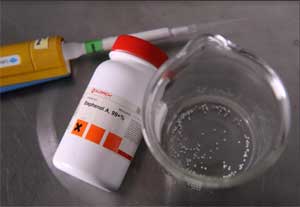- Home
- Editorial
- News
- Practice Guidelines
- Anesthesiology Guidelines
- Cancer Guidelines
- Cardiac Sciences Guidelines
- Critical Care Guidelines
- Dentistry Guidelines
- Dermatology Guidelines
- Diabetes and Endo Guidelines
- Diagnostics Guidelines
- ENT Guidelines
- Featured Practice Guidelines
- Gastroenterology Guidelines
- Geriatrics Guidelines
- Medicine Guidelines
- Nephrology Guidelines
- Neurosciences Guidelines
- Obs and Gynae Guidelines
- Ophthalmology Guidelines
- Orthopaedics Guidelines
- Paediatrics Guidelines
- Psychiatry Guidelines
- Pulmonology Guidelines
- Radiology Guidelines
- Surgery Guidelines
- Urology Guidelines
Endocrine Society disappointed with FDA's statement on Bisphenol A Safety

Bisphenol A (BPA) is a chemical component present in polycarbonate plastic used in the manufacture of certain beverage containers and many food and beverage can liners.They and other endocrine-disrupting chemicals (EDCs ) can harm human health by mimicking, blocking or otherwise interfering with the body’s hormones. Of late FDA Based on it's ongoing safety review of scientific evidence has declared to support the safety of BPA for the currently approved uses in food containers and packaging.The Endocrine Society has expressed disappointment with the U.S. Food and Drug Administration’s (FDA) statement asserting the safety of Bisphenol A (BPA) for use in food containers and packaging.
Uptil 2014, nearly 100 epidemiological studies have been published tying BPA to health problems, according to the Introductory Guide to Endocrine-disrupting Chemicals published by the Society and IPEN, a global network that supports sound chemicals management. These include issues with reproductive health, behavior and metabolism.
“It is premature to draw conclusions based on the release of one component of a two-part report,” said Endocrine Society spokesperson Laura N. Vandenberg, Ph.D. “The National Toxicology Program draft report released Friday included the results of one government study with a partial data set and has yet to undergo peer review.”
The final Consortium Linking Academic and Regulatory Insights on BPA Toxicity (CLARITY-BPA) report will merge the results of research studies carried out in academic labs with those conducted by regulatory agencies. The draft released Friday only contained the studies conducted at the FDA’s National Center for Toxicological Research (NCTR).
The NCTR study did not examine some key areas of concern, such as BPA’s impact on brain development. NCTR researchers focused on how BPA affected growth, weight and tumor development.
“The endpoints studied here do not encompass the full effects of endocrine-disrupting chemicals, especially because the whole point of this study was to compare the NCTR’s endpoints with more sensitive effects evaluated by endocrinologists,” Vandenberg said. “Furthermore, the NCTR’s data does not provide assurance of BPA’s safety. They found certain BPA doses are linked to a higher rate of mammary gland tumors, which is concerning.”
The final CLARITY-BPA report is expected to include academic researchers’ studies of BPA’s effects on additional relevant endpoints. Policymakers and regulators should reserve judgment until the full report is released.
BPA and other endocrine-disrupting chemicals (EDCs) harm human health by mimicking, blocking or otherwise interfering with the body’s hormones. BPA mimics the hormone estrogen. Because tiny amounts of estrogen trigger the development of numerous tissues in unborn children, exposure to low doses of BPA during critical windows of development can have lifelong impacts on health.
As of 2014, nearly 100 epidemiological studies have been published tying BPA to health problems, according to the Introductory Guide to Endocrine-disrupting Chemicals published by the Society and IPEN, a global network that supports sound chemicals management. These include issues with reproductive health, behavior and metabolism.
The Society is the professional organization for scientists who research and physicians who treat hormone conditions, including diabetes, obesity, infertility, thyroid conditions, osteoporosis and hormone-related cancers. Its members include leading scientists researching the effects of exposure to BPA and other EDCs. The Society published a comprehensive Scientific Statement examining more than 1,300 studies on EDCs in 2015.

Disclaimer: This site is primarily intended for healthcare professionals. Any content/information on this website does not replace the advice of medical and/or health professionals and should not be construed as medical/diagnostic advice/endorsement or prescription. Use of this site is subject to our terms of use, privacy policy, advertisement policy. © 2020 Minerva Medical Treatment Pvt Ltd